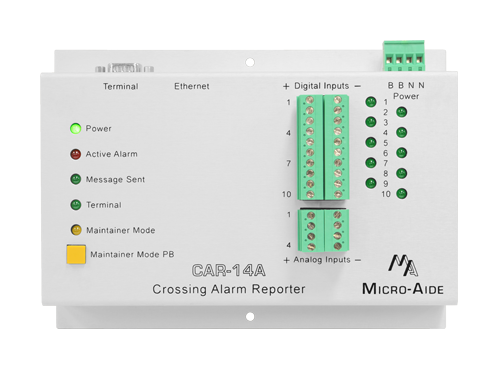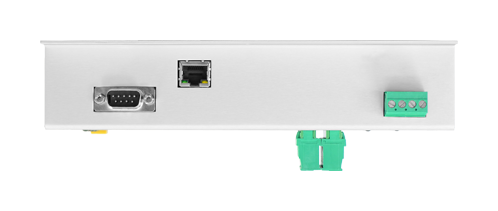On the Outside
5 Activity Indicator LEDs
Active Alarm conditions and several other important activities are indicated by the front panel LEDs.
Maintainer Mode Control
While Maintainer Mode is enabled the sending of Alarm messages can be temporarily suspended. This can be useful when the crossing is being tested or repaired.
10 Digital Inputs
All Digital Inputs are fully isolated by optical means. On/off conditions are 9 to 36Vdc and 0 to 1Vdc, respectively.
10 Digital Input LEDs
The real-time state of each Digital Input is indicated by a separate LED.
4 Analog Inputs
DC voltages in the range of 0 to 51.1V are continuously monitored by the Analog Inputs. Separate user-defined High and Low Limit Values are used to identify abnormal conditions.
Detachable Connectors
All input and power connectors are detachable for ease of installation. Screw-down connectors are used throughout.
BN Power
Typical battery power can be used to power the device. Its operating range is 9 to 36Vdc. The internal power supply is fully isolated.
Serial Terminal Port
Baud rates from 300 to 115,200 are supported. The default Baud rate is 38,400. The Terminal Port can be used with a USB-to-serial adapter. The Terminal Port can also be used to provide remote access to another serial comm device.
Ethernet Port
The Ethernet Port provides access to the customer's VPN through an external cell modem. It also supports remote user access and precise RTC accuracy.


CAR‑14A Documentation



On the Inside
Uses Customer VPN to Report Crossing Alarms
The customer's VPN is used to securely transmit Alarm messages directly to a data gathering and processing server. In turn, the server can be programmed to prepare maintenance logs and trouble tickets. An external cell modem facilitates the device-to-VPN connection.
20 Programmable Alarm Conditions
Alarms can be programmed to report the logical condition and time duration of any potential fault or failure condition.
Reports Numerous Crossing Fault Conditions
Alarms can be programmed to indicate short and long duration power outages, gate up and down problems, active crossing duration, etc.
Provides Periodic Health Check Messages
At pre-set intervals the device will transmit messages that confirm the viability of the device and supporting network.
DHCP for Automatic Network Configuration
The device uses industry-standard DHCP methods to configure its Ethernet interface with the cell modem.
Supports LAN-Based Applications
In cases where a LAN is available, the device can operate independently of a cell modem and VPN.
Non-Volatile Memory With No Internal Batteries
Event Records and the Setup Database are retained indefinitely, even when power is not applied. There are no batteries or other consumables to replace.
Ethernet Port Provides Remote User Interface
The Ethernet Port is used to provide Alarm messaging to the customer's back-of-house server. The HTTP-Get method is employed. SNTP and Telnet protocols are also supported.
100% Accurate Clock (via SNTP)
The Ethernet Port interface supports the SNTP protocol. This allows the device's RTC to be kept 100% accurate by periodic communications with a VPN-accessible time server.
Maintainer Mode Disables Alarm Reporting
As a precaution, Maintainer Mode is automatically disabled after a user-defined interval. After the time-out, Alarm message transmission is resumed.
Terminal Port Provides Remote Device Access
A co-located device with a serial comm port can be connected to the Terminal Port. This allows a remote user to access the co-located device via an Ethernet connection over the VPN.
8 Programmable Virtual Inputs
Logical conditions among any 4 Digital, Analog or other Virtual Inputs are automatically detected using the Virtual Input feature. They can be very useful in precisely defining an Alarm condition.
Internal Temperature Sensor
The internal temperature of the device is continuously monitored.
